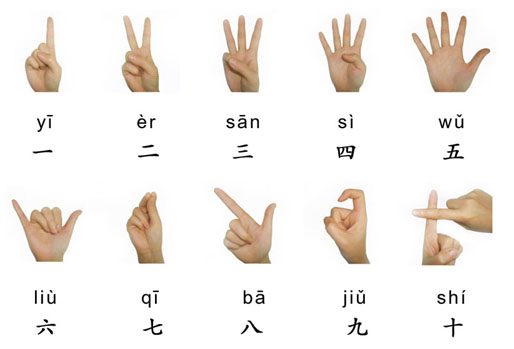Chinese Numbers: An Easy Guide for Beginners
Chinese numbers play an essential role in learners’ lives. Whether you're telling a special someone your age, discussing important dates, or even admitting how many Chinese movies you've seen this year, numbers are indispensable!
However, when it comes to Chinese numbers, it's natural to feel overwhelmed. That's why we've decided to break them down into manageable groups to make it easier for beginners to grasp and use them effectively.
So, without further ado, let's dive into the world of Chinese numbers and explore their fascinating patterns. Next to every number you will find the Chinese characters, the official Romanisation of the word, and the English pronunciation.
Table of Contents
- Chinese Numbers from 1 to 10
- Chinese Numbers: 11 to 20
- Chinese Numbers: 21 to 30
- Chinese Numbers: 41 to 50
- Chinese Numbers: 51 to 60
- Chinese Numbers: 61 to 70
- Chinese Numbers: 71 to 80
- Chinese Numbers: 81 to 90
- Chinese Numbers: 91 to 100
- Chinese Numbers: Hand Signs
- Unlucky Numbers in Chinese
- Lucky Numbers in Chinese
- Learn Mandarin Chinese Now
→Sign Up Now: Free Trial Chinese Mandarin Lesson With a Native Speaker Teacher!←
Chinese Numbers from 1 to 10
Starting with the basics, let's learn the Chinese numbers from 1 to 10:
- 一 (yī) - /yee/
- 二 (èr) - /er/
- 三 (sān) - /sahn/
- 四 (sì) - /suh/
- 五 (wǔ) - /woo/
- 六 (liù) - /lyoo/
- 七 (qī) - /chee/
- 八 (bā) - /bah/
- 九 (jiǔ) - /jyoh/
- 十 (shí) - /shee/
These Chinese numbers are the foundation for building larger numbers in our target language, and they are relatively straightforward to memorise.
Chinese Numbers: 11 to 20
Once you're familiar with the Chinese numbers from 1 to 10, it's easy to construct figures from 11 to 20 by combining the words for ten (十, shí) and the ‘ones’ digit:
- 十一 (shí yī) - /shee yee/
- 十二 (shí èr) - /shee er/
- 十三 (shí sān) - /shee sahn/
- 十四 (shí sì) - /shee suh/
- 十五 (shí wǔ) - /shee woo/
- 十六 (shí liù) - /shee lyoo/
- 十七 (shí qī) - /shee chee/
- 十八 (shí bā) - /shee bah/
- 十九 (shí jiǔ) - /shee jyoh/
- 二十 (èr shí) - /er sh-ee/
Chinese Numbers: 21 to 30
By now, you can surely tell that Chinese numbers are not as difficult as one might have thought! To express Chinese numbers from 21 to 30, use the word for twenty (二十, èr shí) followed by the ones digit:
- 二十一 (èr shí yī) - /er sh-ee yee/
- 二十二 (èr shí èr) - /er sh-ee er/
- 二十三 (èr shí sān) - /er sh-ee sahn/
- 二十四 (èr shí sì) - /er sh-ee suh/
- 二十五 (èr shí wǔ) - /er sh-ee woo/
- 二十六 (èr shí liù) - /er sh-ee lyoo/
- 二十七 (èr shí qī) - /er sh-ee chee/
- 二十八 (èr shí bā) - /er sh-ee bah/
- 二十九 (èr shí jiǔ) - /er sh-ee jyoh/
- 三十 (sān shí) - /sahn sh-ee/
Chinese Numbers: 31 to 40
If, like me, you were born in the 1980s, the next bunch of numbers will come in handy to say your age.
Just combine the word for thirty (三十, sān shí) with the ones digit, and voilá.
Devastating, but useful!
- 三十一 (sān shí yī) - /sahn sh-ee yee/
- 三十二 (sān shí èr) - /sahn sh-ee er/
- 三十三 (sān shí sān) - /sahn sh-ee sahn/
- 三十四 (sān shí sì) - /sahn sh-ee suh/
- 三十五 (sān shí wǔ) - /sahn sh-ee woo/
- 三十六 (sān shí liù) - /sahn sh-ee lyoo/
- 三十七 (sān shí qī) - /sahn sh-ee chee/
- 三十八 (sān shí bā) - /sahn sh-ee bah/
- 三十九 (sān shí jiǔ) - /sahn sh-ee jyoh/
- 四十 (sì shí) - /suh sh-ee/
Chinese Numbers: 41 to 50
To express numbers from 41 to 50, use the word for forty (四十, sì shí) followed by the ones di四十一 (sì shí yī) - /suh sh-ee yee/
- 四十二 (sì shí èr) - /suh sh-ee er/
- 四十三 (sì shí sān) - /suh sh-ee sahn/
- 四十四 (sì shí sì) - /suh sh-ee suh/
- 四十五 (sì shí wǔ) - /suh sh-ee woo/
- 四十六 (sì shí liù) - /suh sh-ee lyoo/
- 四十七 (sì shí qī) - /suh sh-ee chee/
- 四十八 (sì shí bā) - /suh sh-ee bah/
- 四十九 (sì shí jiǔ) - /suh sh-ee jyoh/
- 五十 (wǔ shí) - /woo sh-ee/

Chinese Numbers: 51 to 60
Continue the pattern for Chinese numbers from 51 to 60, use wǔ shí (woo sh-ee) for 50, and then add the single digit:
- 五十一 (wǔ shí yī) - /woo sh-ee yee/
- 五十二 (wǔ shí èr) - /woo sh-ee er/
- 五十三 (wǔ shí sān) - /woo sh-ee sahn/
- 五十四 (wǔ shí sì) - /woo sh-ee suh/
- 五十五 (wǔ shí wǔ) - /woo sh-ee woo/
- 五十六 (wǔ shí liù) - /woo sh-ee lyoo/
- 五十七 (wǔ shí qī) - /woo sh-ee chee/
- 五十八 (wǔ shí bā) - /woo sh-ee bah/
- 五十九 (wǔ shí jiǔ) - /woo sh-ee jyoh/
- 六十 (liù shí) - /lyoo sh-ee/
Chinese Numbers: 61 to 70
Are you getting tired already? Don’t worry, we’re closer to 100 now!
To express numbers from 61 to 70, all you have to do is --you guessed it-- combine the word for sixty (六十, liù shí) with any other digit:
- 六十一 (liù shí yī) - /lyoo sh-ee yee/
- 六十二 (liù shí èr) - /lyoo sh-ee er/
- 六十三 (liù shí sān) - /lyoo sh-ee sahn/
- 六十四 (liù shí sì) - /lyoo sh-ee suh/
- 六十五 (liù shí wǔ) - /lyoo sh-ee woo/
- 六十六 (liù shí liù) - /lyoo sh-ee lyoo/
- 六十七 (liù shí qī) - /lyoo sh-ee chee/
- 六十八 (liù shí bā) - /lyoo sh-ee bah/
- 六十九 (liù shí jiǔ) - /lyoo sh-ee jyoh/
- 七十 (qī shí) - /chee sh-ee/
Chinese Numbers: 71 to 80
Continuing the pattern, here are the Chinese numbers from 71 to 80, which combine the word for 70 (七十, qī shí) and another single digit.
- 七十一 (qī shí yī) - /chee sh-ee yee/
- 七十二 (qī shí èr) - /chee sh-ee er/
- 七十三 (qī shí sān) - /chee sh-ee sahn/
- 七十四 (qī shí sì) - /chee sh-ee suh/
- 七十五 (qī shí wǔ) - /chee sh-ee woo/
- 七十六 (qī shí liù) - /chee sh-ee lyoo/
- 七十七 (qī shí qī) - /chee sh-ee chee/
- 七十八 (qī shí bā) - /chee sh-ee bah/
- 七十九 (qī shí jiǔ) - /chee sh-ee jyoh/
- 八十 (bā shí) - /bah sh-ee/
Chinese Numbers: 81 to 90
Now we are really getting close to the end!
To express numbers from 81 to 90, use the word for eighty (八十, bā shí) followed by the ones digit:
- 八十一 (bā shí yī) - /bah sh-ee yee/
- 八十二 (bā shí èr) - /bah sh-ee er/
- 八十三 (bā shí sān) - /bah sh-ee sahn/
- 八十四 (bā shí sì) - /bah sh-ee suh/
- 八十五 (bā shí wǔ) - /bah sh-ee woo/
- 八十六 (bā shí liù) - /bah sh-ee lyoo/
- 八十七 (bā shí qī) - /bah sh-ee chee/
- 八十八 (bā shí bā) - /bah sh-ee bah/
- 八十九 (bā shí jiǔ) - /bah sh-ee jyoh/
- 九十 (jiǔ shí) - /jyoh sh-ee/
Chinese Numbers: 91 to 100
Congratulations, you’ve made it to the end!
Last but not least, it’s time to explore numbers from 91 to 100: 九十(jiǔ shí) and a single digit.
- 九十一 (jiǔ shí yī) - /jyoh sh-ee yee/
- 九十二 (jiǔ shí èr) - /jyoh sh-ee er/
- 九十三 (jiǔ shí sān) - /jyoh sh-ee sahn/
- 九十四 (jiǔ shí sì) - /jyoh sh-ee suh/
- 九十五 (jiǔ shí wǔ) - /jyoh sh-ee woo/
- 九十六 (jiǔ shí liù) - /jyoh sh-ee lyoo/
- 九十七 (jiǔ shí qī) - /jyoh sh-ee chee/
- 九十八 (jiǔ shí bā) - /jyoh sh-ee bah/
- 九十九 (jiǔ shí jiǔ) - /jyoh sh-ee jyoh/
100一百 (yī bǎi) - /yee bye/
With these Chinese numbers, you’ll be able to talk about significant dates, say how many records TFBOYS records you own, and much more!
Are you ready to keep learning about Chinese numbers?
Chinese Numbers: Hand Signs
In addition to the written form, Chinese numbers also have corresponding hand signs, which are often used in various settings.
These hand signs can be a helpful visual aid for learning and practising Chinese numbers.
To form a number higher than 10, just make two different signs one after the other.

Image via Pinterest
Unlucky Numbers in Chinese
In Chinese culture, certain numbers are considered unlucky due to their pronunciation being similar to words with negative connotations.
For example, the number 4 (四, sì) is considered unlucky because it sounds like the word for "death" (死, sǐ).
Similarly, the number 7 (七, qī) is associated with the word for "gone" or "lost" (去, qù).
Lucky Numbers in Chinese
On the other hand, some numbers are considered lucky in Chinese culture. For example, the number 8 (八, bā) is considered highly auspicious because it sounds similar to the word for "wealth" or "prosperity" (发, fā).
Similarly, the number 9 (九, jiǔ) is associated with the word for "longevity" (久, jiǔ) and is considered lucky. The number 6 (六, liù) is also regarded as fortunate because it sounds like the word for "smooth" or "flow" (流, liú).
Understanding these cultural beliefs surrounding lucky and unlucky numbers in Chinese can be valuable when engaging with Chinese culture and communicating with native speakers.
Did you know about lucky and unlucky numbers in Chinese? Let us know in our social media.
In conclusion, learning Chinese numbers is an essential step towards mastering the language and effectively communicating numerical information. By breaking them down into manageable groups, beginners can gradually build their knowledge and confidence.
Additionally, being aware of the cultural significance of certain numbers will help you memorise them better, as you will be able to associate them with meaningful concepts.
Learn Mandarin Chinese Now
Would you like to go beyond Chinese numbers and start working on your fluency?
By joining Listen & Learn's Mandarin Chinese tailor-made courses, you can benefit from:
- Chinese Native Teachers: Learn from qualified tutors who are native Mandarin Chinese speakers, ensuring authentic language instruction and cultural insights.
- Personalised Lessons: Enjoy personalised lessons designed to meet your specific goals, whether you're learning for business, travel, or personal enrichment. This customised approach allows you to progress at your own pace.
- Flexible Schedule: Schedule your lessons at your convenience, allowing for seamless integration into your busy lifestyle. Whether you prefer face-to-face lessons or online sessions, Listen & Learn offers flexible options to suit your needs.
- Practical Language Skills: Learn practical vocabulary, grammar, and conversational skills to confidently communicate in Mandarin Chinese. With Listen & Learn's communicative approach, you'll be able to apply your knowledge in real-life situations.
- Cultural Insights: Gain a deeper understanding of Chinese culture and traditions, enabling you to engage more effectively with Mandarin speakers and appreciate the nuances of the language.
Whether you're a beginner or aiming to refine your existing proficiency, our comprehensive courses will provide you with the tools and support you need to succeed!
→Sign Up Now: Free Trial Chinese Mandarin Lesson With a Native Speaker Teacher!←
So, don't hesitate! Contact us now to start your Mandarin Chinese learning adventure today with Listen & Learn and discover the wonders of this captivating language!


